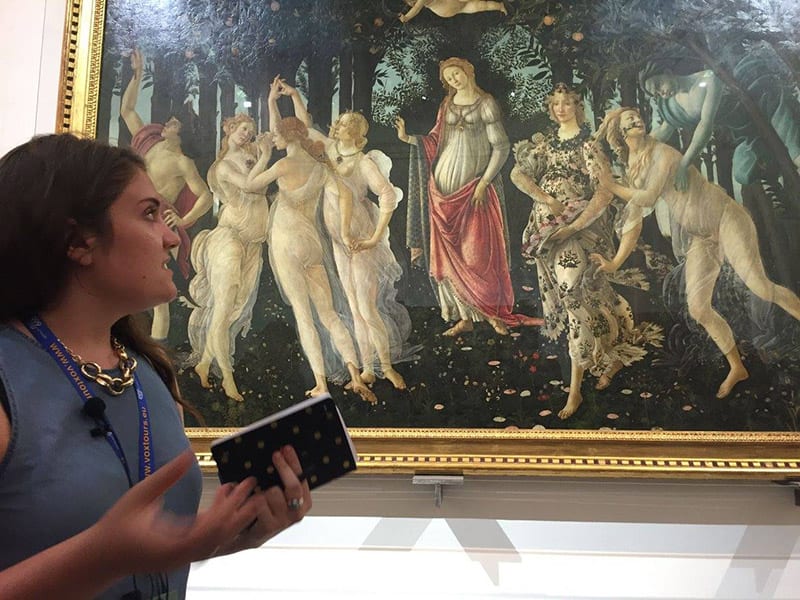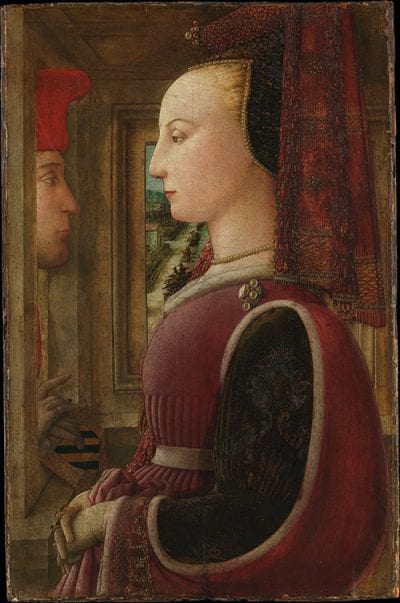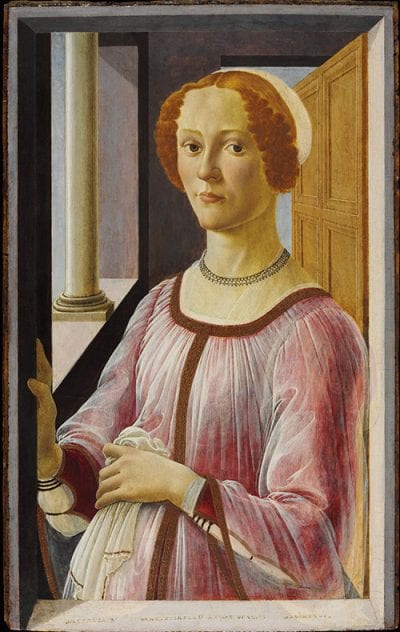
Clio Rom in her studio.

Rom walks us through three portraits that signify a sea change in Renaissance art, literature and philosophy.
An internship at the Palazzo Barberini in Rome launched Clio Rom’s fascination with Renaissance portraiture. Charged with writing a small guide on 18 sacred and secular women’s portraits in the museum’s collection, Rom realized “there was a hole in research on secular women’s portraiture from the 1450s to the 1500s. There were cursory writings on the women but no look at the trend of moving sitters from profile to three-quarter view. That was my entryway.” Guided by mentors Consuelo Lollobrigida, a professor at the University of Arkansas Rome Center, and Lynn Jacobs, distinguished professor of art history, Rom investigated the change in posture that allowed the painted subject to gaze directly at the viewer, and also explored why portraits of women experienced this shift some 30 years later than those representing men.
Rom links Petrarch’s poetry, exalting Laura for her beauty and virtue but fearful of her “fatal gaze,” with static, idealized profile portraits. Neoplatonic philosopher Marsilio Ficino, who believed that looking into a woman’s eyes could inspire a divine frenzy, may have prompted the shift to three-quarter views. Here, Rom walks us through three portraits that signify a sea change in Renaissance art, literature and philosophy.
Reading Renaissance Portraits
By Clio Rom
 Fra Filippo Lippi, Portrait of a Woman with a Man at a Casement, ca. 1440.
Fra Filippo Lippi, Portrait of a Woman with a Man at a Casement, ca. 1440.
Metropolitan Museum of Art, New York City.
This work depicts a woman in profile, encased in an interior. She is looking directly into the gaze of a man, who stands outside the room, presumably in the external world, with his head coming through a window-like opening. In this double portrait Lippi draws a distinct difference between the sexes and the spheres they inhabit: the male is able to exist simultaneously both inside and outside, while the woman is almost claustrophobically trapped within the interior.
A key distinction here is the extravagant detail included in the portrait of the woman versus the lack of detail in depicting the man. The woman, most likely the wife, is dressed in sumptuous garments—a luxurious red dress, complete with ermine sleeves embroidered with golden pomegranate motifs. On her cuff, lealtà (loyalty) is sewn, creating a theme of fidelity that is further expressed by the woman’s painted permanent look into her husband’s eyes. She has no agency to shift her head or gaze anywhere else. She wears a brooch that could represent the family’s crest, which is also replicated at the top of her headdress. Yet with all this luxurious attention to her adorned accessories, Lippi paints the woman pale and fairly flat.
On the other hand, Lippi depicts the man as more lifelike, with a lively complexion. By including the man’s hand with lifted fingers, and his act of peeking into the window, Lippi lends more agency to the man than he gives to the woman, who remains completely static. Lippi includes only the man’s face, not his body or clothing, thereby indicating that the face is the only thing needed to identify him.
There was a gender hierarchy in portraiture. With males, it was biographical. Females were represented as emblems of beauty and virtue.
 Antonio del Pollaiuolo, Profile Portrait of a Young Lady, 1465.
Antonio del Pollaiuolo, Profile Portrait of a Young Lady, 1465.
Gemäldegalerie, Berlin.
This is a conventional profile portrait from mid-fifteenth-century Florence. She’s inside; you can barely see, but there’s some kind of decorative ledge at the bottom of the painting. Profile portraits of women are very formulaic, both in their composition and in the representation of the subject. There is more detail in the dress she’s wearing than there is in her face. The artist follows an ambiguous and vague approach in his depiction of her facial features. While there is a question about her identity, there is no question of her beauty. Her neck is long and graceful, her golden locks are modestly tied up, her clear blue eyes are turned away from the viewer, and her rose pink lips are closed shut. Pollaiuolo invites us to look at and appreciate this girl, but completely restricts her from interaction. Instead of suggesting what words she could speak or movements she could make, the artist leaves us with a surface level impression that highlights the wealth of beauty in both body and textile, while revealing nothing else pertinent to her deeper person. How did we get from this woman who’s unrelatable and undefined to Leonardo’s Mona Lisa in less than 40 years?
 Sandro Botticelli, Portrait of Smeralda Brandini, ca. 1475.
Sandro Botticelli, Portrait of Smeralda Brandini, ca. 1475.
© Victoria and Albert Museum, London.
The portrayal of Smeralda is groundbreaking in the history of women’s portraiture. First, she’s making eye contact with the viewer; this is one of the first female Florentine portraits to do so. Her right hand almost penetrates the picture frame and enters our space. The open door behind her leads to the interior, suggesting that she still belongs in the female domestic space but also indicating the ability to move.
She’s much more modestly dressed; there are no emblems to suggest her conjugal or natal family. She’s still somewhat idealized, but we can see her whole face, which is asymmetrical, more real. Her eyes, paired with slightly pursed lips, communicate a thoughtful, attentive psychology, which adds to our holistic comprehension of her identity.
The emergence of a new intellectual and literary culture in late 15th-century Florence, initiated by the writings of Marsilio Ficino, may have helped prompt this breakthrough in the representation of women. Where Petrarch’s love for Laura was a source of perpetual torment, Ficino’s woman becomes an agent of beauty, through which men find love and God. In contrast to Petrarch, Ficino celebrated the female gaze as a source of heightened spiritual experience.
Rom was accepted into several top art history programs; she will pursue a master’s degree in Renaissance art history at Syracuse University.
More Field Notes Stories
Civil War Meets Mid-Century Modern
Built in 1956 as part of the “Mission 66” federal initiative to modernize national parks, the overlook at Pea Ridge Military Park affords stunning views of a battlefield where the Union army won a decisive victory over Confederate forces. But the mid-century modern structure, still pleasing to 21st-century tastes, landed on a historically sensitive site.
Hydroponic Profits
Honors students Sarah Gould and Laura Gray stand between two wooden stakes embedded in the ground at local community garden Tri Cycle Farms. Today the empty space holds a vision: a greenhouse for hydroponically grown vegetables that will generate profits, and a sustainable future, for the farm. Gould and Gray’s honors theses in biological engineering will help transform this vision into reality.
A Champion for Cultural Competency
Marshall Islanders have moved from a culture where the sick consult healers and pastors into health care marked by waiting rooms, co-pays, and often complicated jargon. Many people in Northwest Arkansas pass them in the grocery store, at a bus stop, or in a doctor’s office, but never truly understand who they are and where they have come from.
Market Entry Masala
Nine cities. 14 days. 23 meetings. It’s an eye-popping schedule, but for accounting and finance major Grayson Greer, it was a bold way to jump-start research on his honors thesis. He designed the two-week trip to India himself, intent on identifying a unified strategy for entering the Indian food and beverage market.
Queens of the Jungle
Senior honors students Kelsey Johnson and Mersady Redding were traipsing through the Belizean jungle one day when they heard low grunts nearby. Stooping down, hoping for a sighting of wild pigs, the two women and their three guides suddenly fell victim to an onslaught of sticks hurled at them from above.






